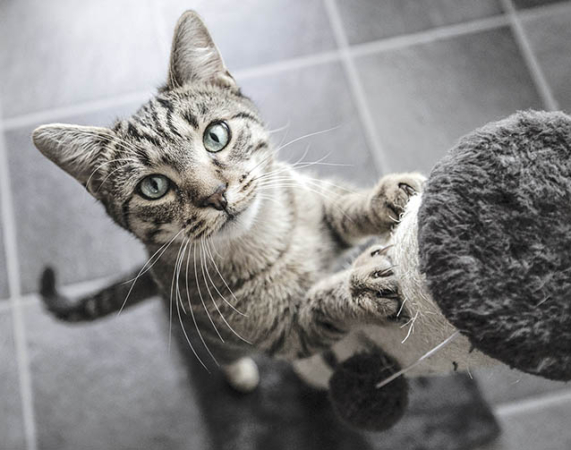Pet ownership can be both joyous and challenging. Every pet misbehaves from time to time, but when behavior issues become part of daily life, pet owners may be wringing their hands wondering how to get to the root of the problem.
Pet owners may not realize they can contribute to common behavior issues. Here’s how to recognize and address pets who may need some behavior redirection.
Scratching: Pet experts note that cats need to scratch as a way to remove the outer sheath of the nail. Scratching also is a way for cats to mark their territory in the wild. Provide plenty of safe and appropriate scratching posts so cats leave the furniture alone. Cordon off areas that are off limits or try sour sprays or other repellents.
Resource guarding: Many pets will show aggression when they guard their possessions from others, whether it is necessary or not. Pets have evolved from wild animals that had to compete for food, mates and territories, so it’s understandable that genetics hasn’t been so quick to catch up with the modern life of pampered pets. Pet owners can opt for adopting young pets that can be hand fed early on or touched or manipulated while eating or enjoying food treats to try to prevent guarding. Older pets who exhibit signs of resource guarding may need the expertise of a Certified Applied Animal Behaviorist.
Inappropriate urination: Just when you think your dog is house trained or a cat has embraced its litter box, you may find he or she is urinating elsewhere. Physical illnesses, such as kidney issues or diabetes, could be the root of the problem. Some animals that are not neutered or spayed may be engaging in “marking” behavior, which is spreading scent around a territory. Getting the pet fixed can alleviate the problem. Speak with a vet first to rule out certain issues.
Barking: Barking to alert someone is at the home may be a trait people look for in a dog. But when a dog’s barking becomes excessive, it could be indicative of a behavioral issue. Dogs may learn to use barking to their benefit. Some dogs may bark to get walks, food or attention — even if it’s negative attention from a person saying “shush.” Some breeds naturally bark more than others. In such instances, barking may be reduced but not entirely eliminated. Again, a behaviorist may be able to help.
Jumping up or overzealous greetings: Similar to barking, some pets greet all visitors to the home (or outside) by jumping up on people. This can be annoying and even dangerous if a big animal jumps on a small person. Reward calm behavior by only giving attention to the pet after he or she calms down. Lavishing attention on an animal as soon as you come home while it is jumping up sets a bad precedent and can lead to a jumping problem.
These are a few common pet behaviors pet owners may need to address to cohabitate peacefully with their animals.
understandable that genetics hasn’t been so quick to catch up with the modern life of pampered pets. Pet owners can opt for adopting young pets that can be hand fed early on or touched or manipulated while eating or enjoying food treats to try to prevent guarding. Older pets who exhibit signs of resource guarding may need the expertise of a Certified Applied Animal Behaviorist.
Inappropriate urination: Just when you think your dog is house trained or a cat has embraced its litter box, you may find he or she is urinating elsewhere. Physical illnesses, such as kidney issues or diabetes, could be the root of the problem. Some animals that are not neutered or spayed may be engaging in “marking” behavior, which is spreading scent around a territory. Getting the pet fixed can alleviate the problem. Speak with a vet first to rule out certain issues.





Leave a Comment
Your email address will not be published. Required fields are marked with *